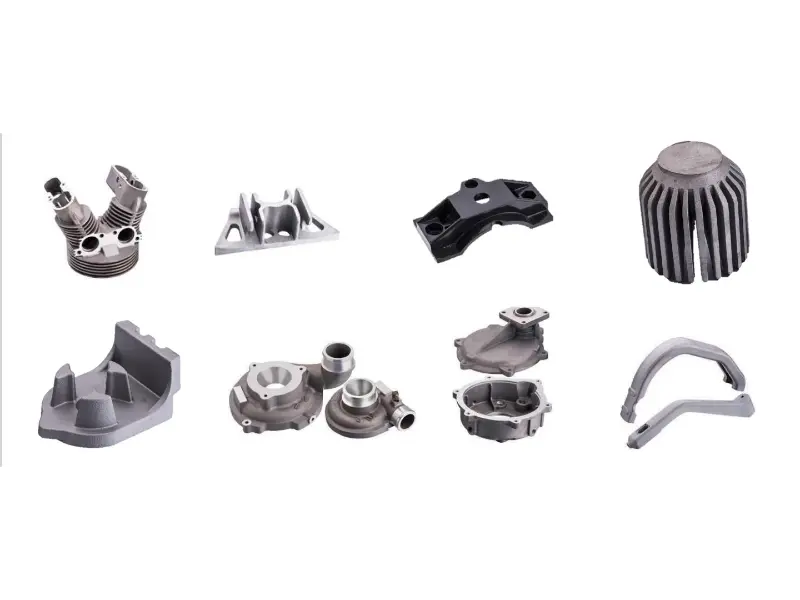What is the Difference Between Gravity Casting and Pressure Casting?
Introduction
Casting processes allow manufacturers to produce complex metal components with precision. Among the most common casting techniques are gravity casting and pressure casting. Both processes use molds to shape molten metal, but they differ significantly in their techniques and applications. This article explores the differences between gravity casting and pressure casting, highlighting their distinct processes, benefits, and the best applications for each.
Understanding Gravity Casting
Gravity casting is a method where molten metal is poured into a mold using the force of gravity alone. This process relies on the natural pull of gravity to fill the mold, without additional external forces. Gravity casting is commonly used for metals like aluminum, copper, and zinc, and is ideal for creating strong, durable components with good surface finish.
Process of Gravity Casting
- Mold Preparation: Molds, often made of metal or sand, are prepared and coated to prevent the metal from sticking.
- Pouring the Metal: Molten metal is poured into the mold, and gravity allows it to flow into every part of the mold cavity.
- Cooling: The mold is left to cool, solidifying the metal into the desired shape.
- Ejecting the Casting: Once cooled, the mold is opened, and the casting is removed for further finishing, if needed.
Advantages of Gravity Casting
- Simple Process: Gravity casting does not require complex machinery, making it cost-effective for small to medium production runs.
- Good Surface Finish: This process can achieve a smooth surface finish, reducing post-processing needs.
- Structural Integrity: The absence of high-pressure force leads to fewer stress points in the casting, resulting in durable parts.
Applications of Gravity Casting
Gravity casting is widely used in the automotive, electronics, and plumbing industries for parts like housings, brackets, fittings, and electrical enclosures. It’s suitable for applications that require high durability and good dimensional accuracy.
Understanding Pressure Casting
Pressure casting involves applying external pressure to force molten metal into the mold. There are two primary types of pressure casting: low-pressure casting and high-pressure die casting. In low-pressure casting, molten metal is forced into the mold at a low pressure. In high-pressure die casting, metal is injected into the mold cavity at high pressure, which ensures rapid filling and precision.
Process of Pressure Casting
- Preparation: The mold is prepared and placed in a machine designed to inject molten metal under controlled pressure.
- Injection: Molten metal is injected into the mold at a specific pressure (low or high) to fill the mold quickly and evenly.
- Solidification: The pressure is maintained as the metal cools, ensuring precise shaping and reducing shrinkage.
- Ejection: Once solidified, the casting is ejected from the mold and may undergo post-processing if necessary.
Advantages of Pressure Casting
- High Precision: Pressure casting produces components with excellent dimensional accuracy and surface finish.
- Fast Production Rates: Particularly with high-pressure casting, this process is well-suited for mass production.
- Thin-Wall Capabilities: Pressure casting can produce thin-walled components that are difficult to achieve with gravity casting.
Applications of Pressure Casting
Pressure casting is ideal for producing automotive parts (e.g., engine blocks, transmission cases), consumer electronics, and industrial equipment parts. Its precision and speed make it well-suited for high-volume production and intricate designs.
Key Differences Between Gravity Casting and Pressure Casting
Method of Metal Filling
- Gravity Casting: Relies on gravity to fill the mold.
- Pressure Casting: Uses external pressure (low or high) to force molten metal into the mold.
Complexity and Cost of Equipment
- Gravity Casting: Typically involves simpler, lower-cost equipment and molds.
- Pressure Casting: Requires specialized machinery, which increases equipment and operational costs but allows for more precision and speed.
Production Speed
- Gravity Casting: Generally slower, suitable for small to medium production runs.
- Pressure Casting: Much faster, making it ideal for high-volume production and mass manufacturing.
Surface Finish and Precision
- Gravity Casting: Provides good surface finish but less precision compared to pressure casting.
- Pressure Casting: Achieves a very smooth surface and high dimensional accuracy, often reducing or eliminating the need for additional finishing.
Suitability for Complex Designs
- Gravity Casting: Suitable for simpler designs with thicker walls.
- Pressure Casting: Capable of producing complex, thin-walled parts with intricate designs.
Typical Applications
- Gravity Casting: Commonly used for durable parts like housings and fittings in automotive and plumbing industries.
- Pressure Casting: Used for precise, high-strength components like engine blocks, electronic casings, and intricate industrial parts.
H2: Choosing Between Gravity Casting and Pressure Casting
When selecting between gravity casting and pressure casting, the choice depends on factors such as:
- Production Volume: Pressure casting is preferable for high-volume production, while gravity casting is suitable for smaller runs.
- Design Complexity: Complex designs and thin-walled parts are better suited to pressure casting.
- Budget: Gravity casting is generally more cost-effective due to its simpler setup and lower equipment costs.
H2: Conclusion
Both gravity casting and pressure casting offer unique benefits for creating metal components. Gravity casting is a straightforward, cost-effective option for parts that require durability and a decent surface finish. Pressure casting, with its ability to produce precise, intricate shapes at high speeds, is ideal for mass production and complex designs. By understanding the key differences between these two methods, manufacturers can choose the right casting technique to meet their specific requirements and ensure high-quality, efficient production.

